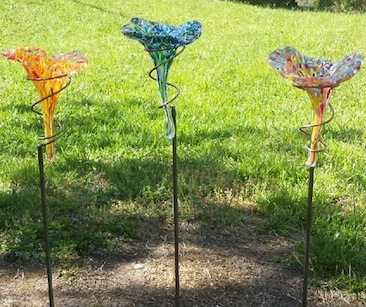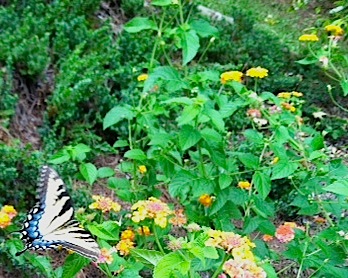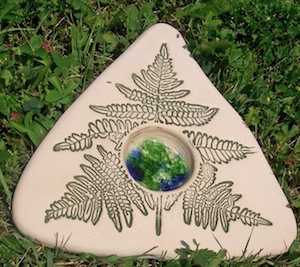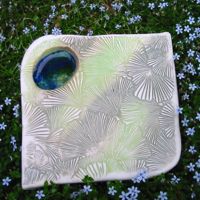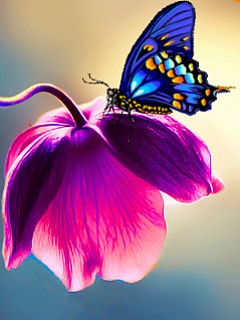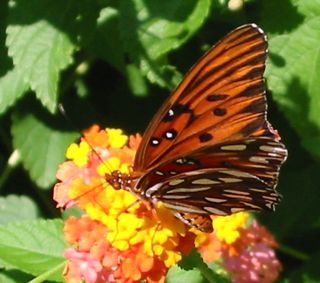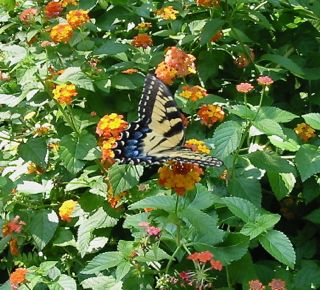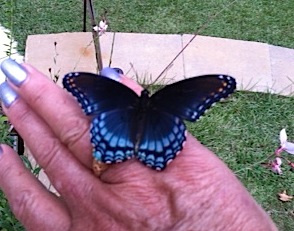-
Naturally Man Made Butterfly Feeders, huh?
A few, yes there were actually three or four butterflies spotted in the yard last month. Because winter dragged it’s sorry butt into spring again this year, there really wasn’t anything blooming yet from where butterflies could draw nectar. Offering leaf misters through summer (which butterflies love), we’re really not ones to offer butterfly feeders, because there’s enough to maintain in our wildlife habitat already!
Quick… run to the store for plants in bloom so the flying gems might have something to eat and decide to stick around! This hibiscus did nicely, as well as this orange tube thing
… I couldn’t tell you the name, but most tube-shape flowers are nectar producers (good to know).
Enter a local artisan and glass blower spotted at a craft show. Hhmmm? Can you make us some glass flowers and put them on a tall stake? We want to use them in the garden as butterfly feeders! After a few weeks and some back & forth… ta-dah!
Some of the most beautiful staked glass butterfly feeders we’d ever seen, they came out awesome! The pics don’t really do them any justice, because sunlight accents the colors and makes them sparkle.
On a 36-inch stake, they’re perfect anywhere in the garden, and are quite versatile for birds too.
Complete with a piece of sea sponge which acts like a wick, butterflies can draw nectar naturally as they do from flowers. Fill it with water as a sipper for any songbird, or a few spoonfuls of grape jelly for orioles, cat birds and other migratory birds. You can even do suet chunks or seed in winter for your resident fliers.
Hand-blown glass and locally made ensure these feeders are unique and high quality, and we can promise if the habitat is right, both butterflies and birds will be winging their way right to them!
-
Add a Ginko or Fern Near Butterfly Feeders
Nobody’s thinking butterflies just yet, but it won’t be too long! With several migrations underway, monarchs, swallowtails and others will be arriving soon. Their numbers are way down which is alarming to scientists, pesticides and climate change being key factors.
If you’d like to have these pollinators gracing your garden, here’s a few simple things to consider:
•Call it quits and abandon the use of any pesticides and herbicides.
•Plant native flowers and shrubs to benefit the flying jewels. Two-part, for food and hosting the chrysalis. A simple search on the web will reveal an abundant list of options for your locale.
•Leaf misters are mighty appealing to butterflies. They’re simple to install and even portable, your garden will grow lush too as a result of the gentle spray of water!
•Add butterfly feeders, in the form of nectar producing flowers, over ripe fruit, or an actual feeder that offers nectar via wicks. The wicks re-create the way butterflies use their long middle antennae to draw nectar from flowers.
•Butterfly Houses? Not so much, but they do look awesome in the landscape!
•Try a stoneware butterfly puddler for a cozy place to warm themselves in the sun.
Aside from an artsy garden accent, they can be used as feeders or easily transformed into a waterless pond by adding some sand and salts. The Ginko is a new puddler available for 2014 that features a rich texture and natural color. Both styles are complete with instructions for best use.
Help these flying jewels by creating habitat to lure and keep them around. Your garden and the butterflies will thank you!
Now if it ever greens up, we’ll get a cool shot of the new one actually being used in the landscape!
-
Nature’s butterfly feeders
If the hummingbird buzz and pre migration isn’t enough activity right now, the local butterfly population seems to have exploded! The past few days have provided some mesmerizing views around the garden. Four species of the jeweled wonders have been spotted flitting around flowering shrubs and plants.
Lantana, butterfly bush and abelia have recently been the most popular of nature’s butterfly feeders. Monarchs and swallowtail butterflies being the most abundant. In past years the leaf misters were especially attractive, but with all the rain this season, they haven’t been employed much. Instead the rains have produced bumper crops of flowers, in turn feeding anyone who pollinates!
Store-bought butterfly feeders are great, especially the ones with wicks that allow butterflies to feed more naturally (like drawing nectar from flowers). Even a plate of over-ripe fruit chunks may entice, but nothing beats nature’s feeders!

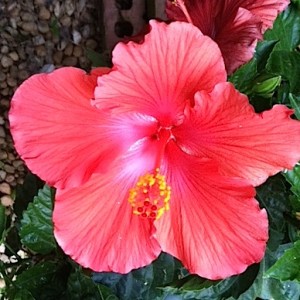
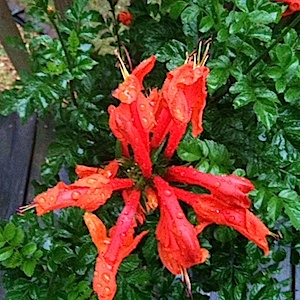 … I couldn’t tell you the name, but most tube-shape flowers are nectar producers (good to know).
… I couldn’t tell you the name, but most tube-shape flowers are nectar producers (good to know).